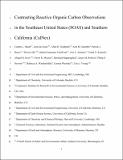| dc.contributor.author | Heald, Colette L | |
| dc.contributor.author | Gouw, Joost de | |
| dc.contributor.author | Goldstein, Allen H | |
| dc.contributor.author | Guenther, Alex B | |
| dc.contributor.author | Hayes, Patrick L | |
| dc.contributor.author | Hu, Weiwei | |
| dc.contributor.author | Isaacman-VanWertz, Gabriel | |
| dc.contributor.author | Jimenez, Jose L | |
| dc.contributor.author | Keutsch, Frank N | |
| dc.contributor.author | Koss, Abigail R | |
| dc.contributor.author | Misztal, Pawel K | |
| dc.contributor.author | Rappenglück, Bernhard | |
| dc.contributor.author | Roberts, James M | |
| dc.contributor.author | Stevens, Philip S | |
| dc.contributor.author | Washenfelder, Rebecca A | |
| dc.contributor.author | Warneke, Carsten | |
| dc.contributor.author | Young, Cora J | |
| dc.date.accessioned | 2021-12-10T17:40:06Z | |
| dc.date.available | 2021-12-10T17:40:06Z | |
| dc.date.issued | 2020 | |
| dc.identifier.uri | https://hdl.handle.net/1721.1/138426 | |
| dc.description.abstract | © 2020 American Chemical Society. Despite the central role of reactive organic carbon (ROC) in the formation of secondary species that impact global air quality and climate, our assessment of ROC abundance and impacts is challenged by the diversity of species that contribute to it. We revisit measurements of ROC species made during two field campaigns in the United States: the 2013 SOAS campaign in forested Centreville, AL, and the 2010 CalNex campaign in urban Pasadena, CA. We find that average measured ROC concentrations are about twice as high in Pasadena (73.8 μgCsm-3) than in Centreville (36.5 μgCsm-3). However, the OH reactivity (OHR) measured at these sites is similar (20.1 and 19.3 s-1). The shortfall in OHR when summing up measured contributions is 31%, at Pasadena and 14% at Centreville, suggesting that there may be a larger reservoir of unmeasured ROC at the former site. Estimated O3 production and SOA potential (defined as concentration × yield) are both higher during CalNex than SOAS. This analysis suggests that the ROC in urban California is less reactive, but due to higher concentrations of oxides of nitrogen and hydroxyl radicals, is more efficient in terms of O3 and SOA production, than in the forested southeastern U.S. | en_US |
| dc.language.iso | en | |
| dc.publisher | American Chemical Society (ACS) | en_US |
| dc.relation.isversionof | 10.1021/ACS.EST.0C05027 | en_US |
| dc.rights | Creative Commons Attribution-Noncommercial-Share Alike | en_US |
| dc.rights.uri | http://creativecommons.org/licenses/by-nc-sa/4.0/ | en_US |
| dc.source | Prof. Heald via Elizabeth Kuhlman | en_US |
| dc.title | Contrasting Reactive Organic Carbon Observations in the Southeast United States (SOAS) and Southern California (CalNex) | en_US |
| dc.type | Article | en_US |
| dc.identifier.citation | Heald, Colette L, Gouw, Joost de, Goldstein, Allen H, Guenther, Alex B, Hayes, Patrick L et al. 2020. "Contrasting Reactive Organic Carbon Observations in the Southeast United States (SOAS) and Southern California (CalNex)." Environmental Science and Technology, 54 (23). | |
| dc.contributor.department | Massachusetts Institute of Technology. Department of Civil and Environmental Engineering | |
| dc.relation.journal | Environmental Science and Technology | en_US |
| dc.eprint.version | Author's final manuscript | en_US |
| dc.type.uri | http://purl.org/eprint/type/JournalArticle | en_US |
| eprint.status | http://purl.org/eprint/status/PeerReviewed | en_US |
| dc.date.updated | 2021-12-10T17:36:21Z | |
| dspace.orderedauthors | Heald, CL; Gouw, JD; Goldstein, AH; Guenther, AB; Hayes, PL; Hu, W; Isaacman-VanWertz, G; Jimenez, JL; Keutsch, FN; Koss, AR; Misztal, PK; Rappenglück, B; Roberts, JM; Stevens, PS; Washenfelder, RA; Warneke, C; Young, CJ | en_US |
| dspace.date.submission | 2021-12-10T17:36:23Z | |
| mit.journal.volume | 54 | en_US |
| mit.journal.issue | 23 | en_US |
| mit.license | OPEN_ACCESS_POLICY | |
| mit.metadata.status | Authority Work and Publication Information Needed | en_US |
